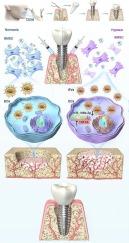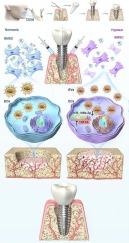Extracellular vesicles from hypoxia preconditioned bone marrow mesenchymal stem cell improve peri-implant osteogenesis under type 2 diabetes condition
IF 11.5
1区 医学
Q1 CHEMISTRY, MULTIDISCIPLINARY
引用次数: 0
Abstract
Purpose
Poor peri-implant osseointegration of dental implants in patients with type 2 diabetes has become a major clinical challenge in recent years. BMSC (bone marrow mesenchymal stem cell)-derived extracellular vesicles may play an important role in peri-implant osseointegration, but the mechanism remains unclear. Improving the therapeutic effect of BMSC-derived extracellular vesicles and exploring their potential mechanisms can help provide new treatment strategies for dental implants in patients with type 2 diabetes.
Methods
The extracellular vesicles derived from hypoxia (Hypo-EVs) or normoxia (Nor-EVs) preconditioned bone marrow mesenchymal stem cells (BMSCs) were co-cultured with BMSCs and human umbilical vein endothelial cells (HUVECs). The effect of extracellular vesicles on BMSCs cell proliferation was detected by CCK-8 assay and EdU assay, and the effect on angiogenesis ability of HUVECs was detected by wound healing assay, transwell migration assay, tube formation assay, enzyme-linked immunosorbent assay (ELISA), quantitative real-time polymerase chain reaction (qRT-PCR) and western blot. A diabetic rat dental implant model was also established and the effect of extracellular vesicles on implant osseointegration was evaluated through micro-CT scanning and histological analysis. The differentially expressed miRNAs between Hypo-EVs and Nor-EVs were identified by high-throughput miRNA sequencing. Subsequently, the target genes and their roles in regulating angiogenesis were predicted and analyzed by bioinformatics analysis and dual luciferase reporter assay.
Results
In vitro experiments indicated that hypoxia preconditioning could elevate extracellular vesicle production and promote cell proliferation of BMSCs and angiogenesis of HUVECs. Moreover, Hypo-EVs promoted peri-implant osteogenesis in rats with diabetes. Further investigation revealed the vital involvement of the miR-106b-5p/HIF-1α axis in promoting peri-implant osseointegration under high glucose condition.
Conclusion
Extracellular vesicles derived from hypoxia-preconditioned BMSCs could improve the peri-implant osseointegration in rats with diabetes by promoting cell proliferation and angiogenesis, and the miR-106b-5p/ HIF-1α axis could be the underlying mechanism.


缺氧预处理骨髓间充质干细胞的细胞外囊泡改善2型糖尿病患者种植体周围成骨
目的2型糖尿病患者种植体种植周骨整合不良已成为近年来临床面临的主要挑战。BMSC(骨髓间充质干细胞)来源的细胞外囊泡可能在种植体周围骨整合中发挥重要作用,但其机制尚不清楚。提高骨髓间充质干细胞来源的细胞外囊泡的治疗效果并探索其潜在机制,有助于为2型糖尿病患者种植牙提供新的治疗策略。方法将缺氧或常氧预处理的骨髓间充质干细胞(BMSCs)与骨髓间充质干细胞和人脐静脉内皮细胞(HUVECs)共培养细胞外囊泡。采用CCK-8法和EdU法检测细胞外囊泡对骨髓间充质干细胞增殖的影响,采用创面愈合法、transwell迁移法、成管法、酶联免疫吸附法(ELISA)、实时定量聚合酶链反应(qRT-PCR)和western blot法检测细胞外囊泡对HUVECs血管生成能力的影响。建立糖尿病大鼠种植体模型,通过显微ct扫描和组织学分析评价细胞外囊泡对种植体骨整合的影响。通过高通量miRNA测序鉴定了hypov - ev和norv - ev之间差异表达的miRNA。随后,通过生物信息学分析和双荧光素酶报告基因试验预测和分析了靶基因及其在血管生成调控中的作用。结果体外实验表明,缺氧预处理可促进人血管内皮细胞细胞外囊泡的生成,促进骨髓间充质干细胞的增殖和血管生成。此外,低ev促进糖尿病大鼠种植体周围成骨。进一步的研究揭示了miR-106b-5p/HIF-1α轴在高糖条件下促进种植体周围骨整合中的重要作用。结论缺氧预处理的骨髓间充质干细胞生成的细胞外囊泡可通过促进细胞增殖和血管生成来改善糖尿病大鼠种植体周围的骨整合,miR-106b-5p/ HIF-1α轴可能是其机制。
本文章由计算机程序翻译,如有差异,请以英文原文为准。
求助全文
约1分钟内获得全文
求助全文
来源期刊

Journal of Controlled Release
医学-化学综合
CiteScore
18.50
自引率
5.60%
发文量
700
审稿时长
39 days
期刊介绍:
The Journal of Controlled Release (JCR) proudly serves as the Official Journal of the Controlled Release Society and the Japan Society of Drug Delivery System.
Dedicated to the broad field of delivery science and technology, JCR publishes high-quality research articles covering drug delivery systems and all facets of formulations. This includes the physicochemical and biological properties of drugs, design and characterization of dosage forms, release mechanisms, in vivo testing, and formulation research and development across pharmaceutical, diagnostic, agricultural, environmental, cosmetic, and food industries.
Priority is given to manuscripts that contribute to the fundamental understanding of principles or demonstrate the advantages of novel technologies in terms of safety and efficacy over current clinical standards. JCR strives to be a leading platform for advancements in delivery science and technology.
 求助内容:
求助内容: 应助结果提醒方式:
应助结果提醒方式:


